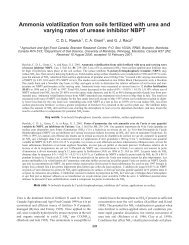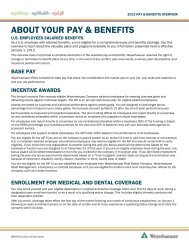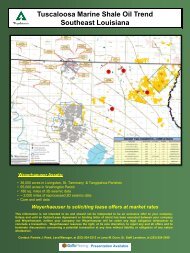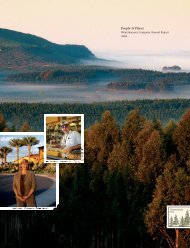Kraft Lignin - Weyerhaeuser
Kraft Lignin - Weyerhaeuser
Kraft Lignin - Weyerhaeuser
You also want an ePaper? Increase the reach of your titles
YUMPU automatically turns print PDFs into web optimized ePapers that Google loves.
Material Safety Data Sheet<br />
<strong>Kraft</strong> <strong>Lignin</strong><br />
<strong>Weyerhaeuser</strong> Company<br />
PO Box 9777<br />
Federal Way, WA 98063-9777<br />
http://www.weyerhaeuser.com/Sustainability/Planet/Products/MSDS<br />
1. Product Identification<br />
Product<br />
<strong>Kraft</strong> <strong>Lignin</strong> (derived from Black Liquor)<br />
Synonyms: <strong>Kraft</strong> lignin powder, lignin, lignin sulfate and thiolignin.<br />
2. Hazardous Ingredients/Identity Information<br />
<strong>Weyerhaeuser</strong> MSDS WC 447-04 (M)<br />
Page 1 of 6 Rev. 08/02/2012<br />
Emergency Phone: (253) 924-5000<br />
Additional Information: (253) 924-3865<br />
CHEMTREC: (800) 424-9300<br />
Revised Date: August 2, 2012<br />
Name CAS# Percent Agency Exposure Limits Comments<br />
<strong>Kraft</strong> <strong>Lignin</strong> 1<br />
8068-05-1 50-100% OSHA<br />
OSHA<br />
15 mg/m 3 - total dust<br />
5 mg/m 3 - respirable<br />
PNOR<br />
PNOR<br />
ACGIH<br />
ACGIH<br />
10 mg/m 3 - inhalable<br />
3 mg/m 3 - respirable<br />
PNOS<br />
PNOS<br />
Sulfur 7704-34-9 0 - 3% OSHA None<br />
1 <strong>Lignin</strong> is derived when pulping black liquor is precipitated and neutralized by acid washing. The product represented on this MSDS<br />
is the result of this process. <strong>Lignin</strong> is a complex polymer that occurs in woody material of higher plants. It is resistant to typical<br />
chemical and enzymatic degradation that occurs in <strong>Kraft</strong> pulp mills. <strong>Lignin</strong> is composed of various intermolecular linkages between<br />
phenylpropanes and guaiacyl, syringyl, p-hydroxyphenyl, and biphenyl nuclei. Sulfur may also be present in varying concentrations.<br />
3. Hazard Identification<br />
Primary Health/Safety Hazards: Warning! Product may form combustible dust concentrations in air<br />
during processing. Specifically, in instances where product dust is suspended in air in sufficient<br />
concentrations in proximity to an ignition source. Users of this product should examine the potential<br />
to generate lignin dust during handling and processing and related combustibility hazards and<br />
controls. See additional comments in MSDS. The primary health hazards posed by <strong>Kraft</strong> <strong>Lignin</strong> are<br />
due to skin and eye contact and dust inhalation.<br />
Appearance and Odor: Brown fine powder with a faint odor<br />
Primary Route(s) of Exposure:<br />
Ingestion:<br />
Skin: pH of product is neutral to mildly acidic; prolonged exposure may result in slight irritation.<br />
Inhalation: prolonged inhalation may result in irritation of the respiratory system.<br />
Eye: contact with dust may cause redness and irritation to eyes.<br />
Medical Conditions Generally Aggravated by Exposure: none identified<br />
Signs and Symptoms of Exposure:<br />
Acute Health Hazards: Irritant to the eyes and skin.<br />
Chronic Health Hazards: Skin sensitization may occur.
3. Hazard Identification (cont’d.)<br />
Carcinogenicity Listing:<br />
NTP: Not listed<br />
IARC Monographs: Not listed<br />
OSHA Regulated: Not listed<br />
4. Emergency and First-Aid Procedures<br />
Ingestion: Not likely to occur under normal use - may irritate mouth, throat and stomach if ingested. Do<br />
not induce vomiting. Rinse mouth out with water. Drink large amounts of water. If persistent irritation<br />
or symptoms occur seek medical help.<br />
Eye Contact: Can cause irritation and reddening. Immediately flush with running water for 15 minutes<br />
including under eyelids. Treat powder in eyes as a foreign object. Flush with water to remove solid<br />
particles. Seek medical help if irritation persists.<br />
Skin Contact: <strong>Kraft</strong> <strong>Lignin</strong> may cause mechanical irritation. Flush contaminated skin with plenty of<br />
water. Wash with mild soap and water.<br />
Skin Absorption: NAP<br />
Inhalation: Avoid inhalation of dust. <strong>Kraft</strong> <strong>Lignin</strong> may cause unpleasant obstruction in the nasal<br />
passages, resulting in dryness of nose, dry cough, sneezing, and headaches. Remove to fresh air.<br />
Seek medical advice if persistent irritation, severe coughing, or breathing difficulties occur.<br />
Note to Physician: None<br />
5. Fire and Explosion Data<br />
Flash Point (Method Used): NAP<br />
Flammable Limits: LEL = NAP (see WARNING below) UEL = NAP<br />
Extinguishing Media: Water and dry chemical<br />
Autoignition Temperature: Variable (typically 400° – 500°C)<br />
Special Firefighting Procedures: Use caution to avoid dispersing dust. Use water to wet down dust to<br />
reduce the likelihood of ignition. Remove burned or wet dust to open area after fire is extinguished.<br />
Unusual Fire and Explosion Hazards: As with other organic dusts, airborne clouds of <strong>Kraft</strong> lignin dust<br />
may ignite and burn with explosive force. Residual sulfur in material may form toxic sulfur<br />
compounds such as sulfur oxides and hydrogen sulfide.<br />
WARNING: May produce combustible dust in air. The typical minimum explosible concentration (MEC)<br />
used for lignin dust is 50g/m3. <strong>Kraft</strong> <strong>Lignin</strong> is also a class II dust and may be explosive under certain<br />
conditions (*Kst dry = 254-338 bar m/s; *MIE dry = 3-10 mJ). Caution should be taken in the<br />
processing, shipping, handling and use of these materials, particularly if they are in a dry state. Dry<br />
fine powder or residues should not be allowed to accumulate and dust should be kept away from<br />
sources of ignition. Use appropriate level of controls and housekeeping to avoid dust accumulations.<br />
The explosibility is decreased if the material is kept moist. Reference NFPA standards 654, 69 and<br />
the NFPA Fire Protection Handbook for guidance.<br />
*Kst the maximum rate of pressure rise is used to calculate the Kst value; an internationally recognized<br />
index used to classify dust explosibility.<br />
*MIE minimum dust cloud ignition energy.<br />
HMIS Rating (Scale 0-4): Health = 2 Fire = 2 Physical Hazard = 1<br />
NFPA Rating (Scale 0-4): Health = 1 Fire = 2 Reactivity = 0<br />
<strong>Weyerhaeuser</strong> MSDS WC 447-04 (M)<br />
Page 2 of 6 Rev. 08/02/2012
6. Accidental Release Measures<br />
Steps to be Taken In Case Material Is Released or Spilled: Sweep up or vacuum spills for recovery or<br />
disposal. Avoid creating dusty conditions and sources of ignition. Place recovered <strong>Kraft</strong> <strong>Lignin</strong> in a<br />
container for proper disposal. Use NIOSH-approved filtering face piece respirator (“dust mask”) and<br />
goggles where ventilation is not possible and exposure limits may be exceeded or for additional<br />
worker comfort.<br />
Other Precautions: Minimize compressed air blowdown or other practices that generate high dust levels<br />
since lignin dust may pose a combustible dust hazard.<br />
7. Handling and Storage<br />
Precautions to be Taken In Handling and Storage: Keep away from sources of direct heat and ignition<br />
sources. Maintain good housekeeping to avoid accumulation of dried lignin dust on exposed<br />
surfaces. Avoid eye contact. Avoid prolonged or repeated contact with skin. Avoid prolonged or<br />
repeated breathing of <strong>Kraft</strong> <strong>Lignin</strong>. Avoid contact with oxidizing agents, alkali and drying oils. Dried<br />
lignin dust may pose a combustible dust hazard.<br />
8. Exposure Control Measures, Personal Protection<br />
Personal Protective Equipment:<br />
RESPIRATORY PROTECTION – Use NIOSH-approved filtering face piece respirator (“dust mask”) and<br />
goggles where ventilation is not possible and exposure limits may be exceeded or for additional<br />
worker comfort or symptom relief. Use respiratory protection in accordance with regulatory<br />
requirements such as the OSHA respiratory protection standard 29 CFR 1910.134. Handle dry<br />
material in ventilated enclosures such as an approved fume hood if possible.<br />
EYE PROTECTION – Tight fitting chemical goggles are recommended.<br />
PROTECTIVE GLOVES – Nitrile or other protective chemical gloves.<br />
OTHER PROTECTIVE CLOTHING OR EQUIPMENT – Chemical Protective clothing - if extremely dusty.<br />
WORK/HYGIENE PRACTICES – Avoid generation of dust, avoid ignition sources and use approved local<br />
exhaust ventilation or handle in fume hood. Wash hands after handling product.<br />
Ventilation: Approved local exhaust ventilation/fume hood.<br />
LOCAL EXHAUST – Provide local exhaust as needed so that exposure limits are met. Ventilation to<br />
control dust should be considered where potential explosive concentrations and ignition sources are<br />
present. The design and operation of any exhaust system should consider the possibility of explosive<br />
concentrations of combustible lignin dust within the system. See SPECIAL section below.<br />
MECHANICAL (GENERAL) – Assure that adequate exhaust or natural ventilation is provided to keep the<br />
airborne concentrations of lignin below exposure limits.<br />
SPECIAL – Ensure that exhaust ventilation and material transport systems involved in handling this<br />
product contain explosion relief vents or suppression systems if the operating conditions justify their<br />
use.<br />
OTHER – NAP<br />
9. Physical/Chemical Properties<br />
Physical Description: Brown fine powder with a faint odor.<br />
Boiling Point (@ 760 mm Hg): NAP<br />
Evaporation Rate (Butyl Acetate = 1): NAP<br />
Freezing Point: NAP<br />
Melting Point: NAP<br />
Molecular Formula: Macromolecule<br />
Molecular Weight: NAP<br />
Oil-water Distribution Coefficient: NAP<br />
Odor Threshold: NAV<br />
<strong>Weyerhaeuser</strong> MSDS WC 447-04 (M)<br />
Page 3 of 6 Rev. 08/02/2012
9. Physical/Chemical Properties (cont’d.)<br />
pH: 3-7<br />
Solubility in Water (% by weight): Soluble in alkaline conditions<br />
Specific Gravity (H2O = 1): NAP<br />
Vapor Density (air = 1; 1 atm): NAP<br />
Loose bulk density (lb/ft 3 ) 19-35<br />
Vapor Pressure (mm Hg): NAP<br />
Viscosity: NAP<br />
% Volatile by Volume [@ 70°F (21°C)]: NAP<br />
10. Stability and Reactivity<br />
Stability: Unstable Stable<br />
Conditions to Avoid: Sources of ignition<br />
Incompatibility (Materials to Avoid): Oxidizing agents and drying oils. Product may ignite at<br />
temperatures in excess of 400 degrees Celsius.<br />
Hazardous Decomposition or By-Products: Thermal decomposition of <strong>Kraft</strong> <strong>Lignin</strong> produces irritating<br />
and toxic fumes and gases including acrid smoke, carbon oxides (CO, CO2), nitrogen oxides (NO,<br />
NO2 etc.), sulfur oxides (SO2, SO3 etc.), aldehydes and organic acids. Natural decomposition of<br />
organic materials such as wood may produce toxic gases and an oxygen deficient atmosphere in<br />
enclosed or poorly ventilated areas.<br />
Hazardous Polymerization: May occur Will not occur<br />
Sensitivity to Mechanical Impact: NAP<br />
Sensitivity to Static Discharge: Yes - in dusty areas.<br />
11. Toxicological Information<br />
Toxicity Data:<br />
Carcinogenic effects: No known significant effects or critical hazards.<br />
Mutagenic effects: No known significant effects or critical hazards.<br />
Teratogenicity/Reproductive toxicity: No known significant effects or critical hazards.<br />
Irritant/Sensitizer: May cause sensitization by skin contact (R 43), according to the EC criteria for<br />
classification and labeling requirements for dangerous substances and preparations (Council<br />
Directive 67/548/EEC).<br />
Skin sensitizer: (Category 1)-According to the Globally Harmonized System of Classification and<br />
Labeling of Chemicals (GHS) of the United Nations (2003).<br />
Ingestion: The oral LD50 value of <strong>Kraft</strong> <strong>Lignin</strong> in Wistar rats was > 2000 mg/kg body weight.<br />
Eyes: Slightly irritating to the eyes.<br />
Components: NAP<br />
Target Organs: Eyes, skin, and respiratory system.<br />
12. Ecological Information<br />
Environmental Fate: Slowly biogrades in water and soil (half-life of 1 month – 1 year).<br />
Environmental Toxicity: Commercial lignin and lignin in <strong>Kraft</strong> wastewater have shown acute toxic<br />
effects on D. magna and V. fischeri (Borton 2004).<br />
Environmental Abiotic Degradation:<br />
Environmental precautions: No known significant effects or critical hazards<br />
BOD and COD: NAV<br />
Biodegradable: Slowly biodegradable. Multiple bacterial degradation pathways have been reported.<br />
<strong>Weyerhaeuser</strong> MSDS WC 447-04 (M)<br />
Page 4 of 6 Rev. 08/02/2012
13. Disposal Considerations<br />
Waste Disposal Method: Incineration in accordance with local, state, and federal regulations is<br />
preferred because emissions can be effectively controlled. Landfill disposal in accordance with local,<br />
state, and federal regulations is acceptable. It is, however, the user's responsibility to determine at<br />
the time of disposal whether your product meets RCRA criteria for hazardous waste. Note that lignin<br />
dust may pose a combustible dust hazard.<br />
14. Transport Information<br />
Mode: (Air, Land, water) Not regulated as a hazardous material by the U.S. Department of<br />
Transportation. Not listed as a hazardous material in Canadian Transportation of Dangerous Goods<br />
(TDG).<br />
Proper Shipping Name: NAP<br />
Hazard Class: NAP<br />
UN/NA ID Number: NAP<br />
Packing Group: NAP<br />
Information Reported for Product/Size: NAP<br />
15. Regulatory Information<br />
TSCA: <strong>Kraft</strong> lignin and sulfur are listed on the TSCA inventory.<br />
CERCLA: This product does not contain ingredients which are subject to the reporting requirements of<br />
CERCLA.<br />
DSL: <strong>Kraft</strong> lignin and sulfur are listed on the Domestic Substance List.<br />
OSHA: 29 CFR 1910.1200, Hazard Communication: Regulated as an irritant and a sensitizer.<br />
State Right to Know:<br />
California Prop 65 – This product does not contain substances identified on the Proposition 65 list at<br />
levels that pose a significant risk for purposes of Section 25249.10(c) or result in an observable effect<br />
for purposes of Section 25249.10(c) of the Act.<br />
New Jersey – This product does not contain substances listed in New Jersey.<br />
Pennsylvania – Sulfur is listed on Pennsylvania’s Appendix A – Hazardous Substance List.<br />
SARA 313 Information: This product does not contain any chemical ingredient(s) with known CAS<br />
numbers that exceed the de minimis reporting levels established by SARA Title III, section 313 and<br />
40 CFR section 372.<br />
SARA 311/312 Hazard Category: This product has been reviewed according to the EPA "Hazard<br />
Categories" promulgated under SARA Title III Sections 311 and 312 and is considered, under<br />
applicable definitions, to meet the following categories:<br />
An immediate (acute) health hazard Yes<br />
A delayed (chronic) health hazard Yes<br />
A fire hazard No<br />
A reactivity hazard No<br />
A sudden release hazard No<br />
FDA: This product is not intended to be ingested or used as a food contact material.<br />
WHMIS Classification: Not a controlled product.<br />
16. Additional Information<br />
Date Prepared: 03/28/2012<br />
Date Revised: 08/02/2012<br />
Prepared By: <strong>Weyerhaeuser</strong> Company Corporate Environment, Health, Safety and Sustainability<br />
<strong>Weyerhaeuser</strong> MSDS available on: http://www.weyerhaeuser.com/Sustainability/Planet/Products/MSDS<br />
<strong>Weyerhaeuser</strong> MSDS WC 447-04 (M)<br />
Page 5 of 6 Rev. 08/02/2012
16. Additional Information (cont’d.)<br />
User’s Responsibility: The information contained in this Material Safety Data Sheet is based on the<br />
experience of occupational health and safety professionals and comes from sources believed to be<br />
accurate or otherwise technically correct. It is the user’s responsibility to determine if the product is<br />
suitable for its proposed application(s) and to follow necessary safety precautions. The user has the<br />
responsibility to make sure that this MSDS is the most up-to-date issue.<br />
Definition of Common Terms:<br />
ACGIH = American Conference of Governmental Industrial Hygienists<br />
AICS = Australian Inventory of Chemical Substances<br />
C = Ceiling Limit<br />
CAS# = Chemical Abstracts System Number<br />
DOT = U. S. Department of Transportation<br />
DSL = Domestic Substance List<br />
EC50 = Effective concentration that inhibits the endpoint to 50% of control population<br />
EINECS = European Inventory of Existing Commercial Chemical Substances or European List of<br />
Notified Chemical Substances<br />
ENCS = Japanese Existing and New Chemical Substances List<br />
EPA = U.S. Environmental Protection Agency<br />
HMIS = Hazardous Materials Identification System<br />
IARC = International Agency for Research on Cancer<br />
IATA = International Air Transport Association<br />
IMDG = International Maritime Dangerous Goods<br />
KECL = South Korean Existing Chemicals List<br />
LC50 = Concentration in air resulting in death to 50% of experimental animals<br />
LCLo = Lowest concentration in air resulting in death<br />
LD50 = Administered dose resulting in death to 50% of experimental animals<br />
LDLo = Lowest dose resulting in death<br />
LEL = Lower Explosive Limit<br />
LFL = Lower Flammable Limit<br />
MSHA = Mine Safety and Health Administration<br />
NAP = Not Applicable<br />
NAV = Not Available<br />
NFPA = National Fire Protection Association<br />
NIOSH = National Institute for Occupational Safety and Health<br />
NPRI = Canadian National Pollution Release Inventory<br />
NTP = National Toxicology Program<br />
OSHA = Occupational Safety and Health Administration<br />
PEL = Permissible Exposure Limit<br />
PNOS = Particulate Not Otherwise Specified<br />
PNOR = Particulate Not Otherwise Regulated<br />
RCRA = Resource Conservation and Recovery Act<br />
STEL = Short-Term Exposure Limit (15 minutes)<br />
STP = Standard Temperature and Pressure<br />
TCLo = Lowest concentration in air resulting in a toxic effect<br />
TDG = Canadian Transportation of Dangerous Goods<br />
TDLo = Lowest dose resulting in a toxic effect<br />
TLV = Threshold Limit Value<br />
TSCA = Toxic Substance Control Act<br />
TWA = Time-Weighted Average (8 hours)<br />
UFL = Upper Flammable Limit<br />
WHMIS = Canada-Workplace Hazardous Materials Information System<br />
<strong>Weyerhaeuser</strong> MSDS WC 447-04 (M)<br />
Page 6 of 6 Rev. 08/02/2012









